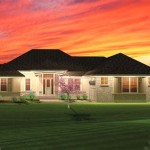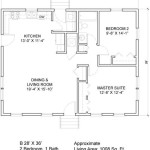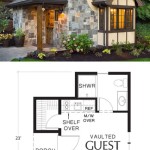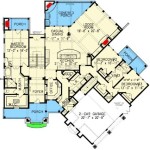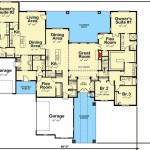Design Your Dream Home With Simple Single Story House Plans UK
The pursuit of a dream home is a deeply personal and often complex undertaking. For many, the ideal dwelling is not characterized by grand scale or intricate design, but rather by simplicity, functionality, and a connection to the surrounding environment. In the United Kingdom, single-story house plans offer a compelling solution for those seeking a streamlined and accessible housing option. These plans, often referred to as bungalows or ranch-style homes, present unique opportunities to create a comfortable and efficient living space tailored to individual needs and preferences.
Single-story homes are experiencing a resurgence in popularity, driven by factors ranging from changing demographics to a growing appreciation for sustainable living. Their inherent accessibility makes them particularly appealing to older adults and individuals with mobility limitations. Additionally, the relatively smaller footprint and simplified construction processes can contribute to lower building costs and reduced environmental impact. This article delves into the key considerations involved in designing a dream home using simple single-story house plans in the UK, exploring the advantages, design elements, and practical tips for achieving a successful outcome.
Understanding the Appeal of Single Story Homes
The allure of single-story living extends beyond mere convenience. These homes offer a unique blend of practical benefits and aesthetic appeal that resonates with a wide range of homeowners. Several factors contribute to their enduring popularity:
Accessibility and Aging in Place: One of the most significant advantages of a single-story home is its inherent accessibility. With all living spaces located on a single level, there are no stairs to navigate, making it an ideal choice for individuals with mobility issues, families with young children, and those planning for their long-term needs. This allows homeowners to "age in place" comfortably and safely, without the need for costly renovations or relocation later in life.
Open Plan Living: Single-story house plans often lend themselves well to open-plan living arrangements. By removing or minimizing internal walls, these plans create a sense of spaciousness and flow, facilitating social interaction and making the home feel larger than its actual square footage. Open-plan designs are particularly well-suited to modern lifestyles, where emphasis is placed on informal gatherings and flexible living spaces.
Connection to the Outdoors: Single-story homes typically offer greater opportunities for seamless integration with the surrounding landscape. Large windows, sliding glass doors, and patios can be incorporated to blur the boundaries between indoor and outdoor living spaces. This connection to nature can enhance well-being and create a more relaxed and inviting atmosphere.
Simplified Construction and Maintenance: Building a single-story home is often simpler and less expensive than constructing a multi-story dwelling. The absence of stairs and complex structural elements can reduce construction time and materials costs. Furthermore, maintenance tasks such as painting and roof repairs are typically easier and more affordable to perform on a single-story structure.
Energy Efficiency: Single-story homes can be designed for optimal energy efficiency. With proper insulation, strategically placed windows, and well-designed ventilation systems, these homes can maintain comfortable temperatures year-round while minimizing energy consumption. This can lead to significant cost savings and a reduced environmental footprint.
Key Design Elements for Single Story House Plans
Designing a successful single-story home requires careful consideration of several key design elements. These elements work together to create a functional, comfortable, and aesthetically pleasing living space.
Layout and Floor Plan: The floor plan is the foundation of any successful home design. For single-story homes, it is crucial to carefully consider the placement of rooms, circulation patterns, and the overall flow of the living space. An efficient layout will minimize wasted space and maximize functionality. Common layout options include linear designs, U-shaped designs, and L-shaped designs, each offering different advantages in terms of privacy, natural light, and outdoor access.
Natural Light and Ventilation: Adequate natural light and ventilation are essential for creating a healthy and comfortable living environment. Large windows, skylights, and strategically placed doors can bring ample daylight into the home and provide natural ventilation. Careful consideration should be given to the orientation of the home to maximize solar gain in the winter and minimize overheating in the summer. Additionally, incorporating features such as operable windows and cross-ventilation can further improve air quality and reduce reliance on air conditioning.
Storage Solutions: Storage is often a challenge in single-story homes, as there is no attic or basement to provide additional space. Therefore, it is crucial to incorporate ample storage solutions throughout the home. This can include built-in cabinets, wardrobes, shelving units, and under-bed storage. Utilizing vertical space and maximizing the efficiency of closets and pantries can help to keep the home organized and clutter-free.
Exterior Design and Landscaping: The exterior design of a single-story home should complement the surrounding landscape and reflect the homeowner's personal style. Common architectural styles for single-story homes in the UK include bungalows, cottage-style homes, and modern minimalist designs. The choice of exterior materials, such as brick, stone, timber, and render, can significantly impact the overall aesthetic. Landscaping plays a crucial role in enhancing the curb appeal of the home and creating a welcoming outdoor space. Consider incorporating features such as gardens, patios, decks, and pathways to create a seamless transition between indoor and outdoor living areas.
Accessibility Features: Even if accessibility is not a primary concern, incorporating universal design principles into the home can make it more comfortable and convenient for all occupants. This can include features such as wider doorways, grab bars in bathrooms, lever-style door handles, and roll-in showers. These features can also increase the resale value of the home and make it more adaptable to future needs.
Practical Tips for Designing Your Dream Home
Designing and building a dream home is a significant investment of time and resources. To ensure a successful outcome, it is essential to approach the project with careful planning and attention to detail. Here are some practical tips to guide you through the process:
Define Your Needs and Priorities: Before embarking on the design process, take the time to carefully define your needs and priorities. Consider your lifestyle, family size, budget, and long-term goals. What are the essential features you require in a home? What are your preferred architectural styles and design aesthetics? What is your budget for the project? Answering these questions will help you to create a clear vision for your dream home and guide the design process.
Work With a Qualified Architect or Designer: Engaging a qualified architect or designer is crucial for creating a well-designed and functional single-story home. An experienced professional can provide valuable insights and guidance throughout the design process, helping you to translate your vision into a practical and aesthetically pleasing plan. They can also help you to navigate building regulations, obtain necessary permits, and manage the construction process.
Consider Site Conditions: The site on which your home will be built can significantly impact the design. Factors such as the topography, soil conditions, orientation, and surrounding landscape should be carefully considered. A professional architect or designer can assess the site conditions and develop a design that maximizes the natural advantages of the site while mitigating any potential challenges.
Prioritize Energy Efficiency: Incorporating energy-efficient features into your home design can save you money on utility bills and reduce your environmental impact. Consider using high-performance insulation, energy-efficient windows and doors, and a renewable energy system such as solar panels. A well-designed home can minimize energy consumption and create a more comfortable and sustainable living environment.
Plan for the Future: When designing your dream home, it is important to consider your future needs and plans. Will your family size increase? Will you need to accommodate aging parents or other family members? Planning for these potential changes now can help to ensure that your home remains functional and comfortable for years to come. Consider incorporating flexible spaces that can be adapted to different uses as your needs evolve.
Obtain Planning Permission: In the UK, most new construction projects require planning permission from the local planning authority. It is crucial to familiarize yourself with the relevant planning regulations and obtain the necessary approvals before starting construction. A qualified architect or designer can assist you with the planning application process and ensure that your design complies with all applicable regulations.
Choose a Reputable Builder: Selecting a reputable and experienced builder is essential for ensuring the quality and craftsmanship of your dream home. Obtain multiple bids from different builders and carefully review their qualifications, experience, and references. Choose a builder who is licensed, insured, and has a proven track record of delivering high-quality work.
By carefully considering these design elements and practical tips, homeowners can create a simple single-story home that perfectly reflects their individual needs and preferences, providing a comfortable, functional, and aesthetically pleasing living space for years to come. The key is to prioritize thoughtful planning, work with qualified professionals, and remain committed to creating a home that truly enhances their quality of life.

One Y Dream Home Php 2024036 1s Pinoy House Plans

Visualize Your Dream Home The Power Of Interactive Floor Plans In Real Estate Renovations My Daily Renovation

Modern House Design How To Achieve Openness In

Five Bedroom House Design The Bridstow Houseplansdirect

3 Bedroom House Plan Stylish Home Designs And Budgets In 2025

Georgian Style House Designs The Allensmore

Single Y Home Designs Clarendon Homes

Bungalow Design Guide To Getting Single Y Living Right Homebuilding

Modern House Design How To Achieve Openness In

Georgian Style House Designs The Allensmore
Related Posts

